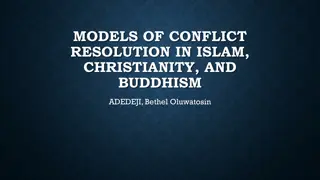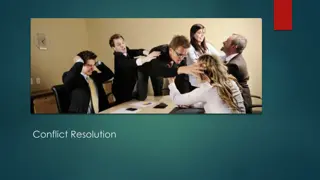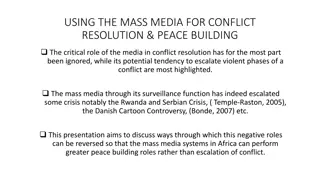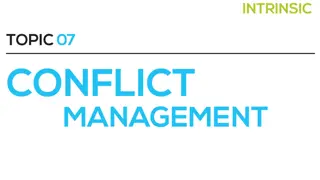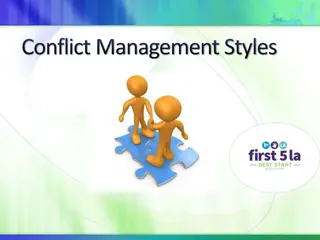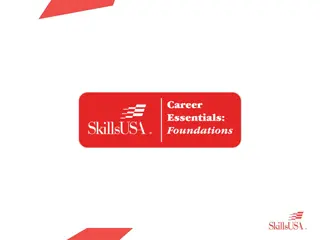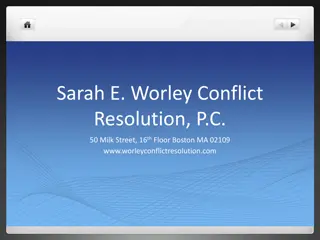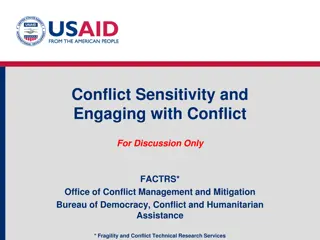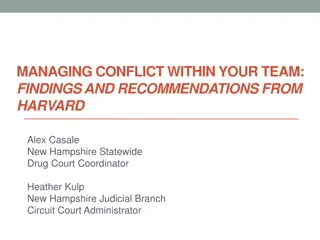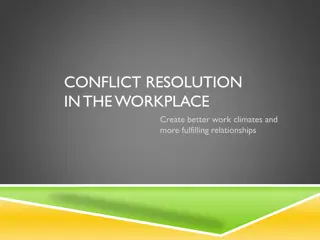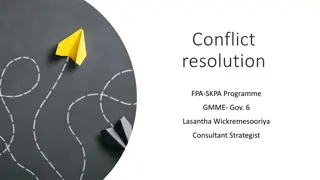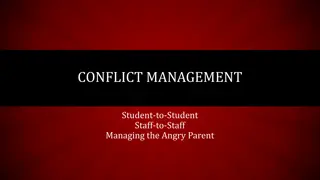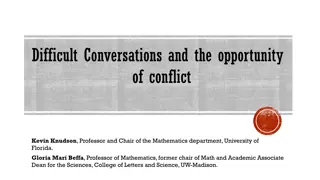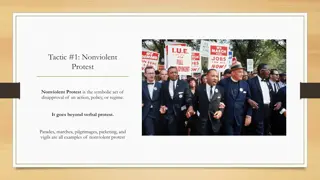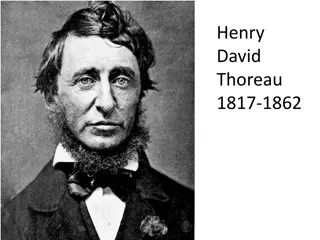Effective Conflict Resolution Through Nonviolent Communication Techniques
Learn essential steps of Nonviolent Communication (NVC), such as making observations, identifying feelings and unmet needs, and requesting solutions or setting boundaries. Discover how to handle conflicts diplomatically and empathetically using NVC principles. Gain insights into active listening, assertiveness, negotiation skills, and collaborative solutions through structured conversations. Enhance your conflict resolution skills by understanding conflict drivers and implementing nonviolent communication strategies for constructive outcomes.
- Conflict Resolution
- Nonviolent Communication
- Active Listening
- Negotiation Skills
- Collaborative Solutions
Download Presentation

Please find below an Image/Link to download the presentation.
The content on the website is provided AS IS for your information and personal use only. It may not be sold, licensed, or shared on other websites without obtaining consent from the author. Download presentation by click this link. If you encounter any issues during the download, it is possible that the publisher has removed the file from their server.
E N D
Presentation Transcript
CONFLICT RESOLUTION: USING NON-VIOLENT COMMUNICATION (NVC) Gemma Perella, gemma@thesli.co.uk
ABOUT THIS SESSION Learn the essential steps of Non Violent Communication (NVC) Learn 4 steps for talking about conflict diplomatically and empathetically Practice drawing out and expressing the underlying needs of a conflict using your own example Learn how to use NVC to work towards constructive solutions
ABOUT ME Personal Development Trainer Creating confident, resilient and emotionally intelligent young leaders. Providing training courses using a mixture of coaching, instruction and activity based learning.
YOUR EXAMPLE Identify a conflict in your life next to you Identify a conflict in your life 0-4 in difficulty out of 10 Something you can talk about Does NOT involve the person sitting OK if it was resolved or unresolved OK if it is work, study or personal
CONFLICT RESOLUTION Active listening Assertiveness Structuring a difficult conversation Negotiation skills Looking for collaborative solutions Understanding conflict drivers Non Violent communication
NONVIOLENT COMMUNICATION Nonviolent Communication: A Language of Life Marshall B. Rosenberg 1. 2. 3. 4. State the situation as an observation Identify the feelings Identify what needs are not being met Request a solution or state the boundary
1) MAKE OBSERVATIONS Judgements are our opinions, interpretations, assumptions, exaggerations, guesses and even spin Observations are the things we can see as definitely true like we are watching the scenario on a video recording.
1) MAKE OBSERVATIONS A colleague waltzed last minute waltzed by my desk on Friday afternoon and pressured me last minute social media for their campaign - and I gave in pressured me into doing gave in to them. A colleague waltzed by my desk on Friday afternoon and pressured me into doing last minute social media for their campaign - and I gave in to them. A colleague came to my desk at 3.30pm on Friday afternoon and said This campaign needs a final push before 5.30pm and I have too much to do. You are really good at communications, you should do it. Even though I knew I was busy I agreed to take on the work.
1) MAKE OBSERVATIONS You derailed justify derailed our meeting into talking about your latest fad justify some extra resources. latest fad project so that you could You derailed our meeting into talking about your latest fad project so that you could justify some extra resources. In our last team meeting you raised a point that was not on our agenda. We spent 20 minutes talking about a new project you are running and you asked for extra resources.
YOUR EXAMPLE Think about your conflict example. 1) 1) State the situation as an observation State the situation as an observation Factually, what happened?
2) IDENTIFY FEELINGS Afraid Agitated Angry Annoyed Anxious Aversion Bored Confused Depressed Disconnected Dislike Embarrassed Enraged Envious Exhausted Fatigue Frustrated Guilty Hate Helpless Hopeless Hurt Self conscious Sensitive Suspicious Tense Tired Vulnerable Withdrawn Worried Yearning Impatient Insecure Jealous Lonely Lost Nervous Outraged Pain Puzzled Restless Sad
3) IDENTIFY NEEDS CONNECTION acceptance affection appreciation attention belonging care comfort communication community companionship compassion consideration consistency cooperation empathy inclusion intimacy CONNECTION kindness love mutuality nurturing respect/self-respect safety / security stability support to know and be known to see and be seen trust warmth PHYSICAL WELL- -BEING PHYSICAL WELL air food health movement/exercise rest/sleep sexual expression safety shelter touch water BEING PEACE PEACE beauty ease equality faith harmony healing inspiration transcendence MEANING awareness challenge clarity competence consciousness contribution discovery growth hope inspiration learning mourning order / structure participation purpose self-expression understanding MEANING AUTONOMY choice dignity freedom independence power space spontaneity AUTONOMY PLAY celebration creativity humour joy Leisure PLAY HONESTY authenticity integrity presence trust HONESTY
I STATEMENTS I feel ____ because I needed ____. I am ____ because I value ____. I was ____ because ____ is important to me. I was irritated because I need the consistency of sticking to an agreed agenda. I feel overwhelmed. I already have a lot of work and need the space to complete those tasks before taking on more.
YOUR EXAMPLE 2 & 3) Identify feelings and needs 2 & 3) Identify feelings and needs What were you feeling in your situation? What were your unmet needs? Use an I statement Empathise with the feelings and needs of the other person
4) REQUEST A SOLUTION Use your understanding of your needs (and theirs) to move forwards Requests: Would we be able to Could we try Would you be willing to It would help me if I need / want / would like Statements: I will / will not I am going to When --- then I will If --- then I have the right to...
YOUR EXAMPLE 4) Request a solution OR state a boundary 4) Request a solution OR state a boundary What do you (both) need that would support the situation? Be specific Be positive Ask, don t demand
NVC 1) 1) State the situation as an observation 2) 2) Identify the feelings 3) 3) Identify what needs are not being met 4) 4) Request a solution OR state the boundary State the situation as an observation Identify the feelings Identify what needs are not being met Request a solution OR state the boundary 1) On Friday at 3.30pm you asked me to help you do a final push on your social media campaign. Even though I knew I was busy I agreed to take on the work. 2) I felt frustrated with myself. 3) Belonging is important to me so I took on too many tasks and put myself under pressure. 4) It would help me if I had at least two days notice for tasks so that I can plan my work flow.
NVC 1) 1) State the situation as an observation 2) 2) Identify the feelings 3) 3) Identify what needs are not being met 4) 4) Request a solution OR state the boundary 1) In our last team meeting you raised a point that was not on our agenda. We spent 20 minutes talking about a new project you are running and you asked for extra resources. 2) I felt annoyed 3) Because I value structure and fairness and I wanted to discuss an agreed agenda point. 4) When you have suggestions please submit them in advance or wait until AOB so that we can keep to our agenda. State the situation as an observation Identify the feelings Identify what needs are not being met Request a solution OR state the boundary
WRAPPING UP Learned the 4 step NVC model for discussing conflict Practiced articulating what you need to find a solution Conflict resolution skills take time, practice and complimentary skills
FURTHER SUPPORT NVC resource sheet
www.thesli.co.uk Training programmes Coaching Resources and blogs Mailing list www.thesli.co.uk CONFLICT RESOLUTION: USING NON-VIOLENT COMMUNICATION (NVC) Gemma Perella, gemma@thesli.co.uk




